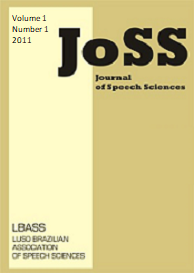Abstract
Meireles and Barbosa have presented studies that show the influence of speech rate on speech rhythmic restructurings (see [1] for data in French, and [2], [4] for data in Brazilian Portuguese). Rhythmic restructuring is defined here as the reorganization of stress groups (henceforth SG) as speech rate increases. The speech rate influence on speech rhythmic reorganizations can be explained by the Dynamical Speech Rhythm model [2] [5] (henceforth DSR). In this model, speech rhythm is considered as a “consequence of the variation of perceived duration along the entire utterance” [2]. Intrinsic segmental duration is normalized through the use of abstract vowel-to-vowel (henceforth VV) duration (see [2] [4]). Entrained, abstract VV duration is used as the control parameter to generate prosodic variation. The maxima of VV duration delimitate produced SG as rhythmic units in Brazilian Portuguese. Using the DSR model as a theoretical framework, Meireles and Barbosa have run acoustic and articulatory experiments that show the influence of speech rate on speech rhythm (see [4] for a broad explanation): (i) Meireles and Barbosa [4] investigated how speech rate acts to articulatorily reorganize lexical stress in Brazilian Portuguese; (ii) Meireles and Barbosa [4] ran acoustic and articulatory (EMMA) experiments, so as to study speech rhythm reorganizations due to speech rate increase in Brazilian Portuguese. This paper follows the line of reasoning of Barbosa’s and Meireles’ research. Nevertheless, it sheds new light on the phenomenon of rhythmic restructuring since it correlates phonetic variables (mean and standard deviation of VV and SG durations) with social variables (gender and age). Main results have shown that social variables variation reorganizes speech rhythm and modifies some phonetic parameters in the following way: a) the standard deviation of vowel-to-vowel (VV) duration and stress group duration is smaller for the male gender and the advanced age; b) stress group duration tends to be vary less for the male gender and the advanced age (rhythmic restructurings make VV units smaller, but with a greater number of VV units per stress group, what results in a statistically constant stress group duration at these variables); c) the number of VV units per stress group proportionally increases from the young age to the advanced age due to rhythmic restructurings; and d) the male gender and the advanced age exacerbate the mixture character of Brazilian Portuguese rhythm, i.e., tendencies to syllable as to stress-timed rhythm.
References
Barbosa, P. A. Caractérisation et génération automatique de la structuration rythmique du français. PhD Thesis. Institut National Polytechnique de Grenoble, France, 1994.
Barbosa, P. A. Incursões em torno do ritmo da fala. Campinas, São Paulo: Pontes Editores, Fapesp, 2006.
Barbosa, P. A. From syntax to acoustic duration: A dynamical model of speech rhythm production. Speech Communication 49, 725–742, 2007.
Boersma, Paul; Weenink, David. Praat: doing phonetics by computer (version 4.6.35) [Computer program]. Retrieved October 22, 2007, from http://www.praat.org/, 2007.
Deshaies-Lafontaine, D. A Socio-Phonetic Study of a Québec French Community: Trois-Rivières. PhD Dissertation, University College London, 1974.
Dressler, W.U. e Wodak, R. Sociophonological methods in the study of sociolinguistic variation in Viennese German. Language in Society 11, 339-370, 1982.
Foulkes, P. Sociophonetics. IN: Brown, Keith (ed.) Encyclopedia of Language and Linguistics, 2nd ed., Amsterdam, 2006.
Meireles, A. R. Self-organizing rhythms in Brazilian Portuguese: speech rate as a system perturbation. Saarbrücken: VDM Verlag, 2009.
Meireles, A. R., Barbosa, P. A. Speech rate effects on speech rhythm In: Speech Prosody 2008 Conference, 2008, Campinas. Proceedings of the Speech Prosody 2008 Conference. Campinas: RG. v.1. p.327 – 330, 2008.

This work is licensed under a Creative Commons Attribution 4.0 International License.
Copyright (c) 2021 Jair de Almeida Silva, Alexsandro Rodrigues Meireles

